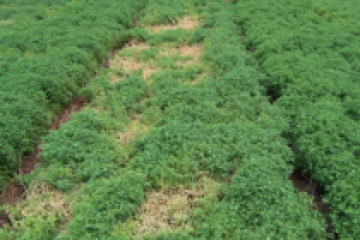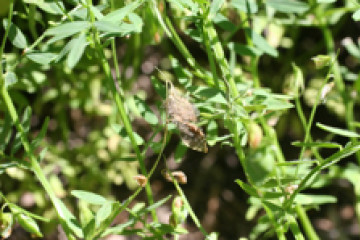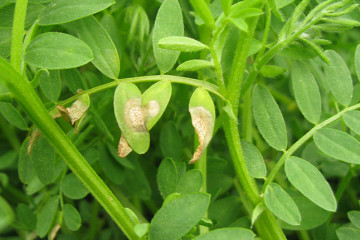Australian Pulse Bulletin
Lentil fungicide guide: 2016 season
In many regions seasonal conditions are extremely wet, with continuing rain events and waterlogged soils. Decisions about the viability of crops need to be made early rather than later if disease has taken hold in the crop. It may be a better option to abandon crops and prepare for a following crop if diseases are apparent and environmental conditions continue to favour the disease over the next few weeks (saturated soils, average daily temperatures >15°C and high humidity).
The crop needs continuing fungicide protection for good pod fill and many paddocks are not accessible by ground sprayers to give adequate spray coverage required.
If an early decision about crop viability is made, extra costs for crop protection are avoided and nutrients will be available for following crops.
In light of the ongoing pressure for fungal disease in lentil crops this year, Pulse Australia has compiled this Bulletin to provide a consolidated list of chemicals and approved usage patterns, for both on-label and well as approved by permit.
Note that some of the permit-enabled use patterns are via Emergency Use Permits, which have been specifically approved to deal with the current fungal conditions. These permits will expire once the 2016 season has concluded.
For more detailed information: Lentil: Integrated disease management
-

Botrytis affecting a susceptible variety (W. Hawthorne)
-

Botrytis on lentil pod (W. Hawthorne)
-

Ascochyta on lentil leaves (J Davidson).
Ascochyta blight
Ascochyta blight (caused by Ascochyta lentis) (AB) is a potentially serious but manageable disease of lentil in Australia. Most current varieties are unlikely to have significant yield losses due to ascochyta blight. However, ascochyta blight does infect lentil pods and seed, causing a discolouration of grain that will significantly reduce the marketability and value of affected grain.
The disease appears on leaves and pods as round, whitish lesions with brown margins. Black fruiting bodies in the lesions distinguish the disease from spots caused by herbicide damage. Severe infections cause leaf yellowing. Tips of stems wilt, turn brown and die. Pod infection spreads to the seeds, which turn purple-brown and shrivel in whole or in part.
Wind borne spores from infected lentil stubbles can blow into adjacent paddocks and infect new lentil crops. Infection can occur at any stage of plant growth, but is more significant during late flowering and pod fill. Wet weather favours disease development and rain splash spreads spores onto new crop growth within the crop, including pods.
Ascochyta blight of field pea, chickpea and faba bean are specific to those crops and will not cause ascochyta blight on lentil.
Fungicides need to be applied prior to rain events in spring to give good foliage cover before the canopy has closed. If wet weather persists further sprays may be required to maintain leaf cover.
Botrytis grey mould (Botrytis spp.)
Botrytis grey mould (Botrytis fabae and B. cinerea) can infect any above-ground plant parts, but is generally only a problem in wet years, when it can cause crop devastation. A dense crop, lodging and rain in spring provide ideal conditions for the disease to develop in the crop canopy. The fungus that causes botrytis grey mould has a wide host range and is always present to some extent on pulse crop residues. Host range includes faba bean, vetch, chickpea, field pea and lucerne. Airborne spores released from old infected crop residues early in the season can infect new crops. Grey mould can infect lentil at any time during the growing season, but epidemics generally develop late, after the plant canopy has closed. Flowers and pods are particularly sensitive to botrytis grey mould infection, which reduces pod set and seed quality. After harvest, the fungus survives as mycelium on plant residues and as sclerotia in the soil to enable its long-term survival. Taller, erect varieties or slower growing varieties are at less risk of infection, irrespective of their disease rating. Lush growth or lodging that provides a humid microclimate under the crop canopy enhances the inherent variety susceptibility.
Timing and management of crop canopy closure is important in botrytis grey mould control. Airflow through the crop canopy reduces the in-crop humidity and this reduces the severity of infection.
Apply foliar fungicides just prior to canopy closure to prevent botrytis grey mould establishing in a crop. Fungicides should be considered in crops or varieties that are more susceptible to botrytis grey mould infection.
For more detailed information: Lentil: Integrated disease management
Emergency Use Permits for fungicide on lentils
- PER82994 Amistar (Azoxystrobolin) Ascochyta blight / Current to 30-Nov-2016
- PER81533 Custodia / Ascochyta blight, grey mould / Current to 30-Sep-2017
- PER81406 Captan / Ascochyta blight, chocolate spot, grey mould / Current to 30-Sep-2018
- PER82964 Prosaro 420 / Ascochyta blight, grey mould / Current to 21-Oct-2016
- PER82973 Chlorothalonil / Ascochyta blight, grey mould / Current to 30-Nov-2016
- PER82995 Cabrio (Pyraclostrobin) / Ascochyta blight / Current to 30-Nov-2016
- PER830031 Filian (Boscalid) / Botrytis / Current to 30-Nov-2016
- PER83004 Rovral (Iprodione) / Botrytis / Current to 30-Nov-2016
- PER83068 Titan (Azoxyst 120 + Cypro 80) / Ascochyta / Current to 30-Nov-2016
- PER83305 Propiconazole / Faba bean, Chickpea & Lentil / Ascochyta blight / Current to 30-Nov-2016
Fungicides registered for disease control in lentils
| Lentil Foliar Fungicide
|
Trade Name example
|
Ascochyta blight
|
Botrytis grey mould
|
WHP Harvest
|
|---|---|---|---|---|
| Chlorothalonil 720
|
CC Barrack 720
|
1.0–2.0 l/ha
|
Permit 1.0–2.0 l/ha
|
14 days
|
| Mancozeb 750
|
Dithane SC
|
1.0–2.2 l/ha
|
1.0–2.2 l/ha
|
28 days
|
| Mancozeb 420
|
Penncozeb SC
|
1.8–3.95 l/ha
|
NR
|
28 days
|
| Carbendazim
|
Spin Flo
|
NR
|
500 ml/ha
|
28 days
|
| Captan 900
|
CC Captan 900
|
Permit 1.1 kg/ha
|
Permit 1.1 l/ha
|
14 days
|
| Captan 800
|
CC Captan 800
|
Permit 1.25 kg/ha
|
Permit 1.25 kg/ha
|
14 days
|
| Prothio 210 + Teb 210
|
Prosaro 420
|
Permit 600–700 ml/ha
|
NR
|
21 days
|
| Azoxystrobin 250
|
Amistar
|
Permit 0.5–1.1 l/ha
|
NR
|
14 days
|
| Azoxyst 120 + Teb 200
|
Custodia
|
Permit 1.0 l/ha
|
Permit 1.0 l/ha
|
28 days
|
| Pyroclostrobin 250
|
Cabrio
|
Permit 400–600 ml/ha
|
NR
|
30 days
|
| Boscalid
|
Filian
|
NR
|
Permit 1.2 kg/ha
|
21 days
|
| Azoxyst 120 + Cypro
|
Titan
|
Permit 400 ml/ha
|
NR
|
28 days
|
| Iprodione 500
|
Rovral Aquaflo
|
NR
|
Permit 1.0 l/ha
|
28 days
|
| Propiconazole
|
Tilt, Throttle, FMC Prop | Permit
Tilt 500 ml/ha Throttle 250 ml/ha FMC Prop 227 ml/ha |
NR | 14 days |
Many of the Emergency Use Permits have short term expiry dates (e.g. 30/11/2016)
NR = Not Registered (not effective for this disease)
Read the LabelAs with any chemical application, care should be taken to observe all the label recommendations for each product. Many of our pulse crops are exported for human consumption, so market access is dependent on having the product free of chemical residues. Australian has a reputation for providing clean and safe produce so it is vital that this is maintained by using chemicals according to regulations. All permits have label recommendations for use rate and with-holding periods (WHP) that must be observed so grain will comply with Maximum Residue Limits (MRL) allowable for market access. |
Key contacts
Pulse Australia Industry Development Managers
- Paul McIntosh
Phone: 0429 566 198 - Phil Bowden
Phone: 0427 201 946
Support and funding acknowledgement
Disclaimer
Information provided in this guide was correct at the time of the date shown below. No responsibility is accepted by Pulse Australia for any commercial outcomes from the use of information contained in this guide.
The information herein has been obtained from sources considered reliable but its accuracy and completeness cannot be guaranteed. No liability or responsibility is accepted for any errors or for any negligence, omissions in the contents, default or lack of care for any loss or damage whatsoever that may arise from actions based on any material contained in this publication.
Readers who act on this information do so at their own risk.
Copyright © 2015 Pulse Australia
All rights reserved. The information provided in the publication may not be reproduced in part or in full, in any form whatsoever, without the prior written consent of Pulse Australia. www.pulseaus.com.au
Last updated: 23 September 2016
